Abstract
1 About 45% of singly-housed male mice showed timidity (alert postures, running away, defensive postures) instead of aggression on interactions in pairs with group-housed male mice, though their partners did not show any aggression. The isolation-induced timidity was stable in repeated interactions. Timid mice also showed locomotion (walking across cage and rearing) and a small amount of sociable activity (sniffing, following partners and climbing over them). 2 Diazepam (5 mg/kg), chlordiazepoxide (20 mg/kg), chlorpromazine (7.5 mg/kg) and barbitone (60 mg/kg) given orally inhibited the isolation-induced timidity without reducing other motor activities in the timid mice. Imipramine lessened timidith only in a dose (80 mg/kg) which also decreased other components of behaviour in the timid isolates. (+)-Amphetamine and lysergic acid diethylamide (LSD) increased the timid response. 3 Comparison of the inhibition of timid activities with changes in other behaviour occurring at the same time seems a better measure of selective timidity-reducing effects of drugs than the rota-rod test. 4 Diazepam (5 mg/kg) increased sociable and locomotor activities. Barbitone (20 and 60 mg/kg) increased sociable activities; however, the higher dose also evoked some aggression in timid mice. 5 Behaviour of timid singly housed male mice seems to be a good measure for prediction of activity of drugs in relieving anxiety as well as for detection of aggression-evoking and sociability-increasing effects of drugs.
Full text
PDF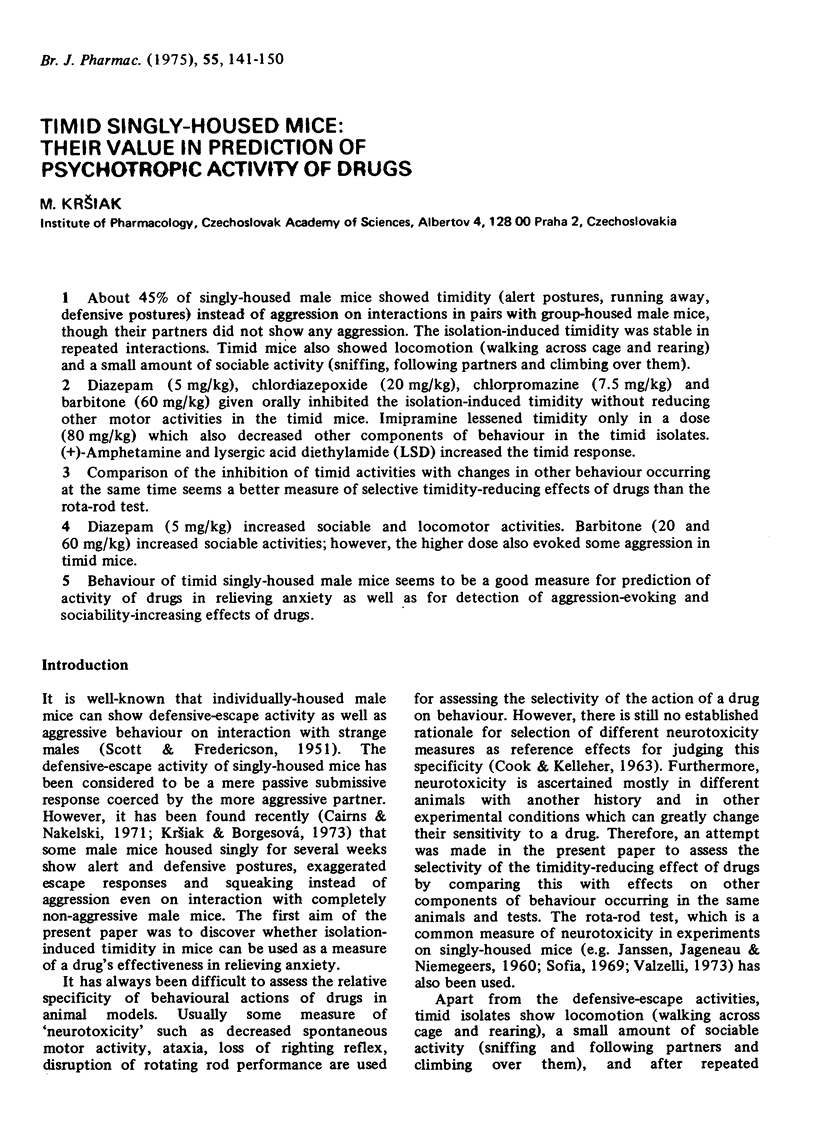
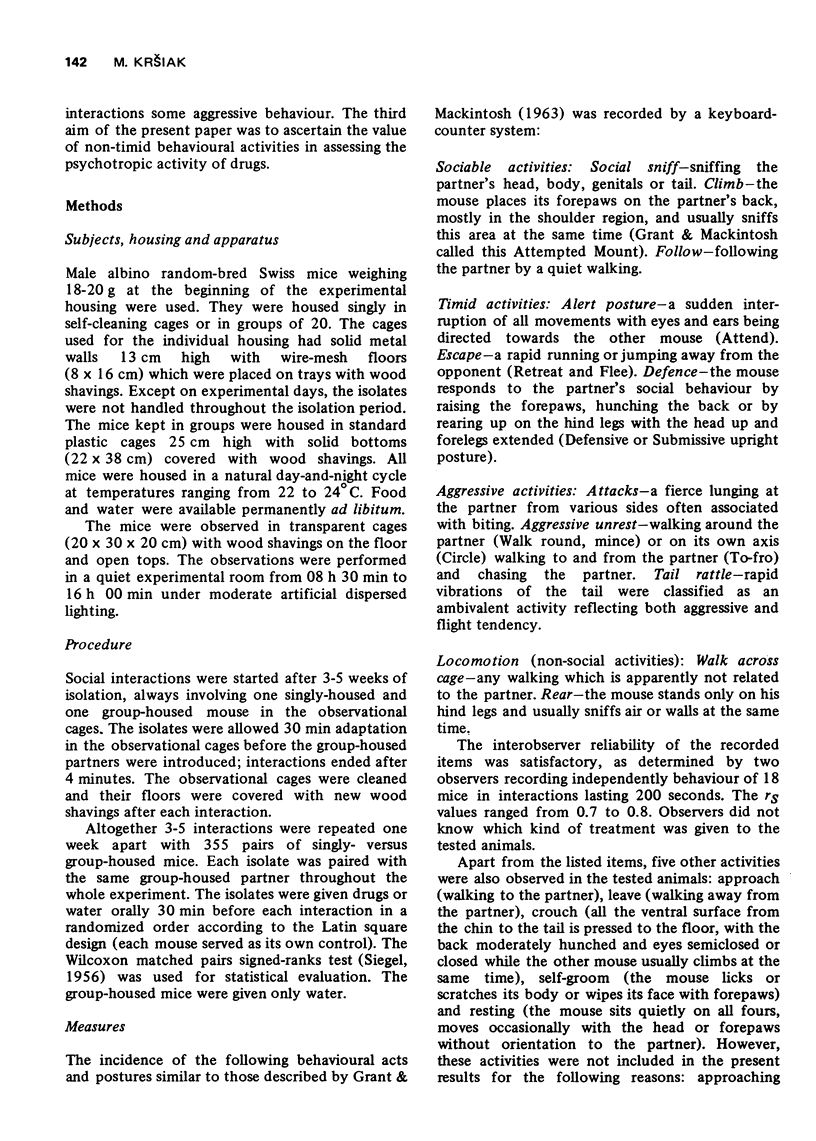

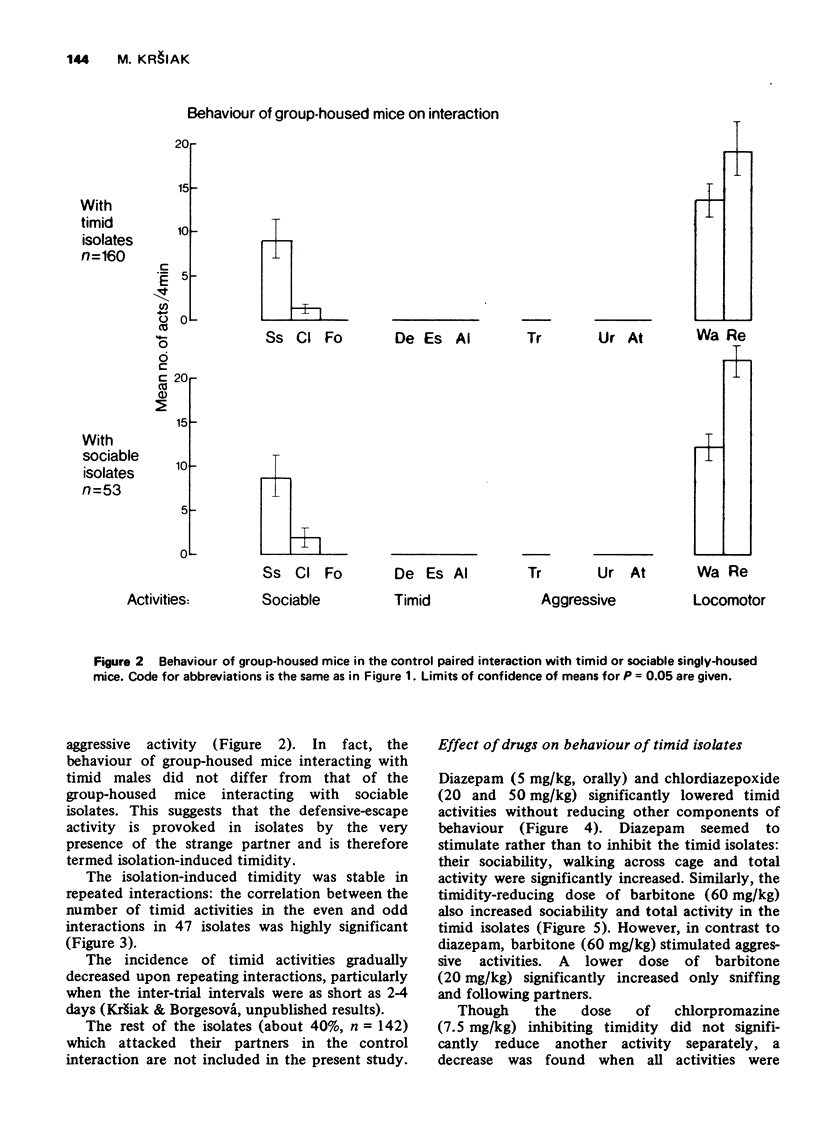
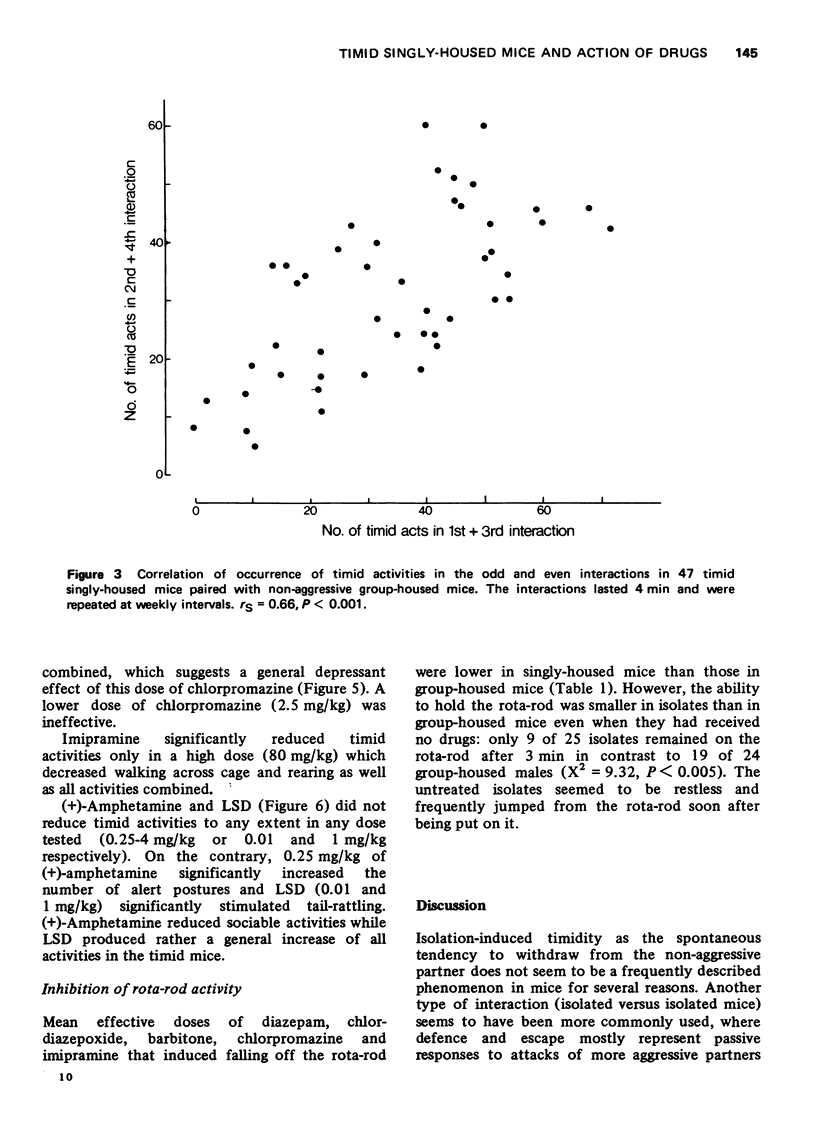
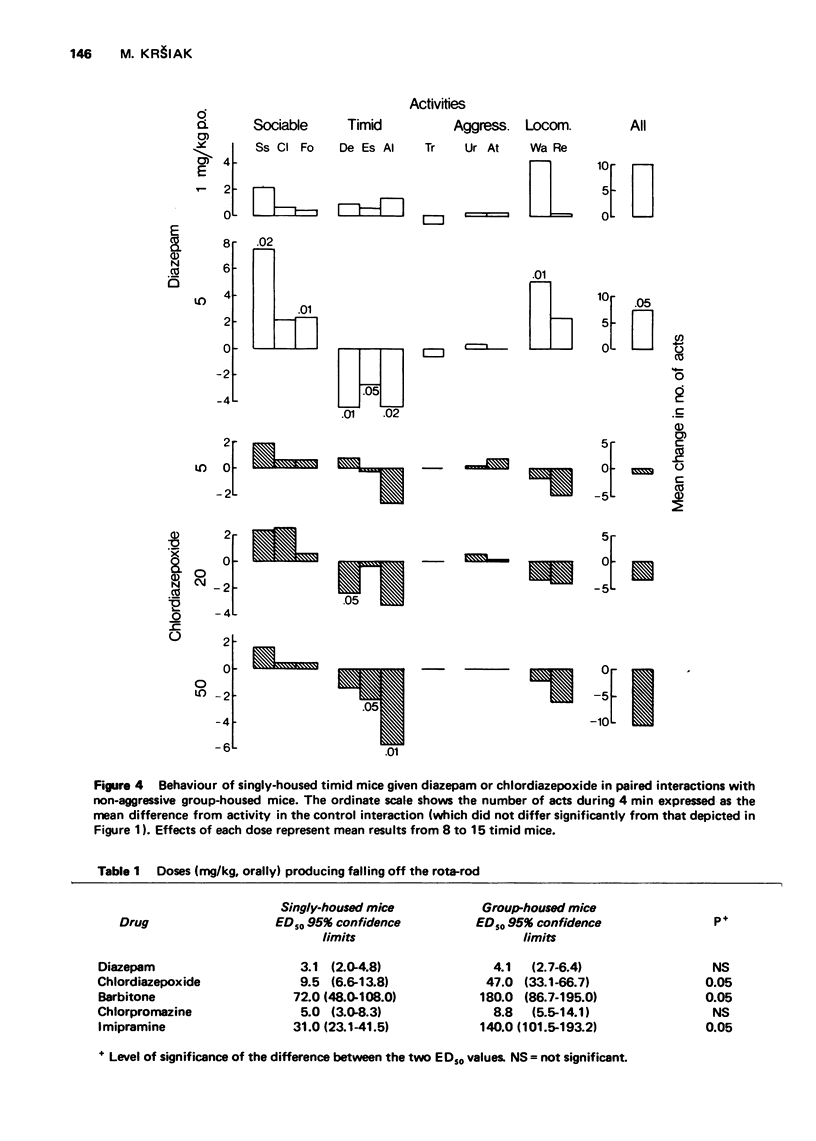

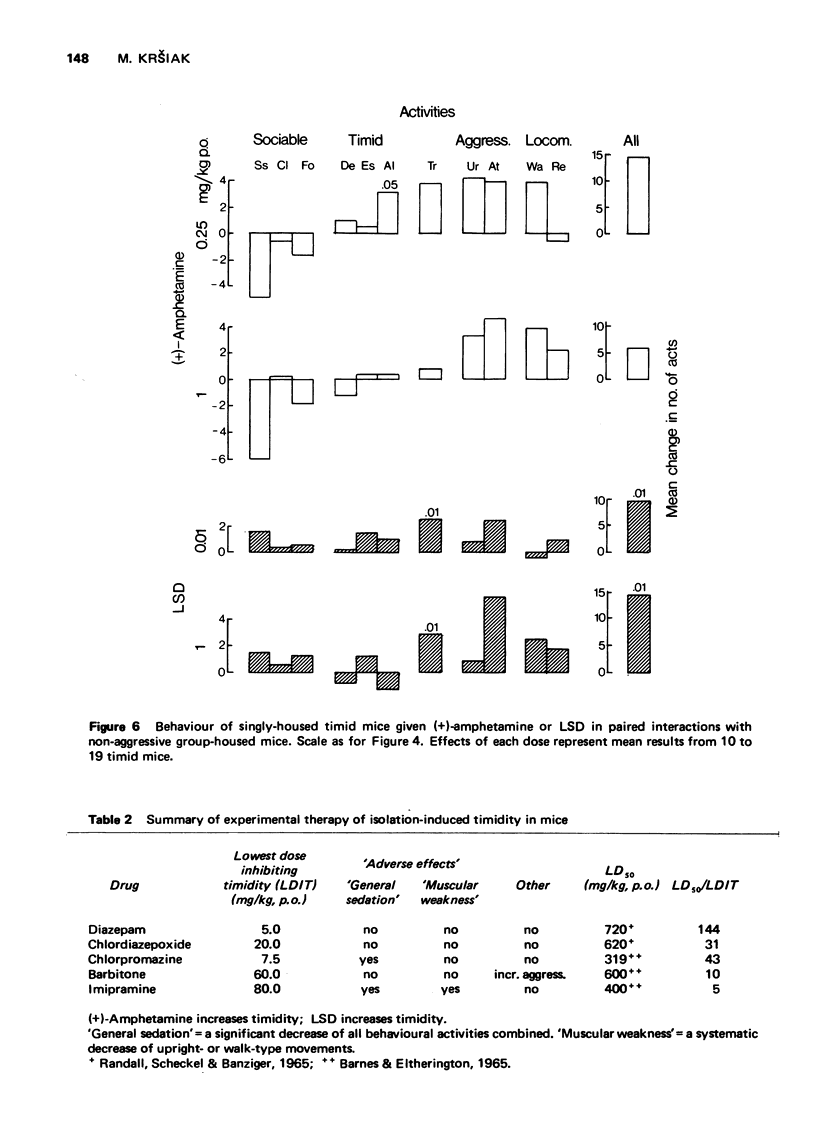


Selected References
These references are in PubMed. This may not be the complete list of references from this article.
- Cairns R. B., Nakelski J. S. On fighting in mice: ontogenetic and experiential determinants. J Comp Physiol Psychol. 1971 Mar;74(3):354–364. doi: 10.1037/h0030584. [DOI] [PubMed] [Google Scholar]
- Da Vanzo J. P., Daugherty M., Ruckart R., Kang L. Pharmacological and biochemical studies in isolation-induced fighting mice. Psychopharmacologia. 1966;9(3):210–219. doi: 10.1007/BF02198481. [DOI] [PubMed] [Google Scholar]
- Gluckman M. I. Pharmacology of 7-chloro-5-(o-chlorophenyl)-1,3-dihydro-3-hydroxy-2H-1,4-benzodiazepin-2-one (lorazepam; Wy 4036). Arzneimittelforschung. 1971 Jul;21(7):1049–1055. [PubMed] [Google Scholar]
- JANSSEN P. A., JAGENEAU A. H., NIEMEGEERS C. J. Effects of various drugs on isolation-induced fighting behavior of male mice. J Pharmacol Exp Ther. 1960 Aug;129:471–475. [PubMed] [Google Scholar]
- Kjellberg B., Randrup A. Disruption of social behaviour of vervet monkeys (Cercopithecus) by low doses of amphetamines. Pharmakopsychiatr Neuropsychopharmakol. 1973 Nov;6(6):287–293. doi: 10.1055/s-0028-1094393. [DOI] [PubMed] [Google Scholar]
- Krsiak M., Borgesová M. Aggression and timidity induced in mice by isolation. Act Nerv Super (Praha) 1973 Mar;15(1):21–22. [PubMed] [Google Scholar]
- Poole T. B. Some studies on the influence of chlordiazepoxide on the social interaction of golden hamsters (Mesocricetus auratus). Br J Pharmacol. 1973 Jul;48(3):538–545. doi: 10.1111/j.1476-5381.1973.tb08360.x. [DOI] [PMC free article] [PubMed] [Google Scholar]
- Randall L. O., Scheckel C. L., Banziger R. F. Pharmacology of the metabolites of chlordiazepoxide and diazepam. Curr Ther Res Clin Exp. 1965 Sep;7(9):590–606. [PubMed] [Google Scholar]
- SILVERMAN A. P. ETHOLOGICAL AND STATISTICAL ANALYSIS OF DRUG EFFECTS ON THE SOCIAL BEHAVIOUR OF LABORATORY RATS. Br J Pharmacol Chemother. 1965 Apr;24:579–590. doi: 10.1111/j.1476-5381.1965.tb01749.x. [DOI] [PMC free article] [PubMed] [Google Scholar]
- Silverman A. P. Barbiturates, lysergic acid diethylamide, and the social behaviour of laboratory rats. Psychopharmacologia. 1966;10(2):155–171. doi: 10.1007/BF00455976. [DOI] [PubMed] [Google Scholar]
- Silverman A. P. The social behaviour of laboratory rats and the action of chlorpromazine and other drugs. Behaviour. 1966;27(1):1–38. doi: 10.1163/156853966x00083. [DOI] [PubMed] [Google Scholar]
- Sofia R. D. Effects of centrally active drugs on four models of experimentally-induced aggregession in rodents. Life Sci. 1969 Jul 1;8(13):705–716. doi: 10.1016/0024-3205(69)90259-8. [DOI] [PubMed] [Google Scholar]
- Syme L. A., Syme G. J. Effects of chlorpromazine and methamphetamine on sociability in rats. Psychopharmacologia. 1973 Aug 22;32(1):81–84. doi: 10.1007/BF00421709. [DOI] [PubMed] [Google Scholar]
- Valzelli L., Giacalone E., Garattini S. Pharmacological control of aggressive behavior in mice. Eur J Pharmacol. 1967 Nov;2(2):144–146. doi: 10.1016/0014-2999(67)90040-4. [DOI] [PubMed] [Google Scholar]
- Welch B. L., Welch A. S. Graded effect of social stimulation upon d-amphetamine toxicity, aggressiveness and heart and adrenal weight. J Pharmacol Exp Ther. 1966 Mar;151(3):331–338. [PubMed] [Google Scholar]
- YEN C. Y., STANGER R. L., MILLMAN N. Ataractic suppression of isolation-induced aggressive behavior. Arch Int Pharmacodyn Ther. 1959 Dec 1;123:179–185. [PubMed] [Google Scholar]


